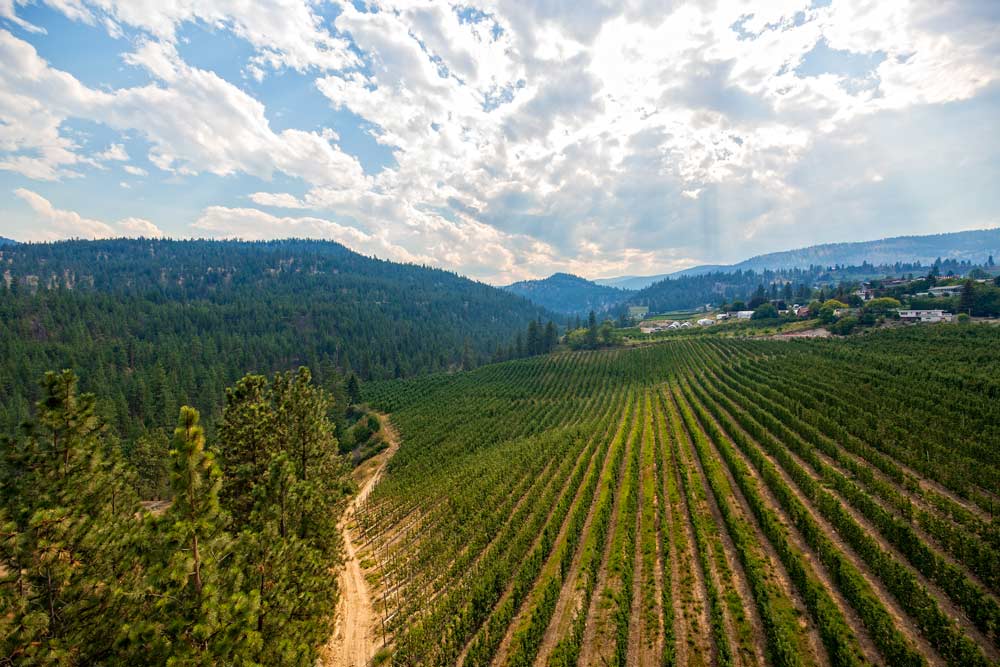
Viewed from the Trout Creek Trestle bridge in Summerland, British Columbia, in July, Stinging Bee Orchard’s high-density Ambrosia apple planting cuts into the wooded canyons leading toward Okanagan Lake. British Columbia apple growers, plenty accustomed to high-density plantings, face a crossroads now that their ace variety, Ambrosia, is now open to American growers. (TJ Mullinax/Good Fruit Grower)
The family history of third-generation farmer Madeleine van Roechoudt is one of innovation and change. They were among the first in British Columbia to use dwarfing rootstocks and trellises and to adopt new varieties.
But she’s unsure what’s next.
“Where do we go from here,” said van Roechoudt, president of Dorenberg Orchards in Lake Country, nearly 20 miles north of Kelowna in the Okanagan Valley.
She’s not the only one asking. The crossroads facing British Columbia’s apple industry provided one of the economic backdrops for the 2018 study tour of the International Fruit Tree Association, or IFTA, held in the region in late July.
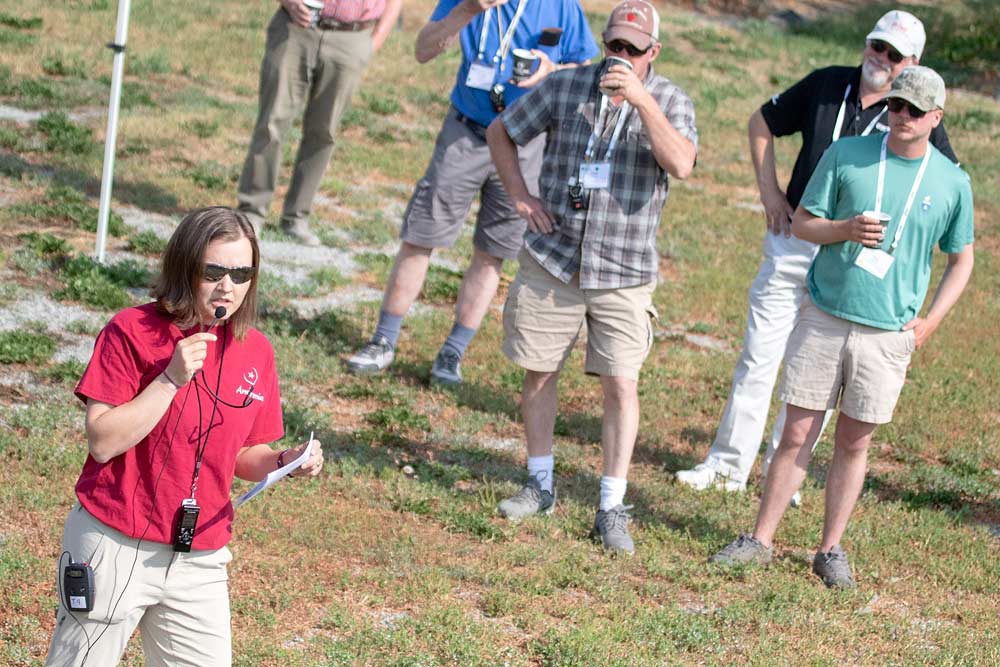
Madeleine van Roechoudt, president of Dorenberg Orchards in Lake Country, British Columbia, leads a tour of her farm in July during the 2018 International Fruit Tree Association summer tour. The third-generation company was among the early adopters of Ambrosia and trellised horticulture.
(TJ Mullinax/Good Fruit Grower)
Canada’s westernmost province is forecast to produce 3.3 million 42-pound bushels of apples in 2018, putting it third in the nation behind Ontario and Quebec. Gala and Ambrosia are far and away the most common varieties.
However, the patent on Ambrosia, long a stalwart of high grower returns in the region, has expired, while Gala returns have waned in recent years. “I’m not even banking on Gala,” said Joel Carter, a Summerland area grower. “I don’t think anybody is.”
Finding new cultivars is tough, though packers and cooperatives are doing what they can. Owners of high-value club varieties usually seek growers with vast acreage, something few British Columbia growers have due to high land prices and regulatory restrictions on development.
Many apple growers are shifting to cherries, capitalizing on later varieties that harvest in July, August and even September.
Apples are still the king horticultural crop in the British Columbia interior, but apple acreage has dropped by half in the past 20 years while the cherry footprint has tripled, according to Statistics Canada.
Other growers are switching to wine grapes. Some have tried selling to cideries, which so far have provided a secondary market outlet to only a small volume of dessert apples.
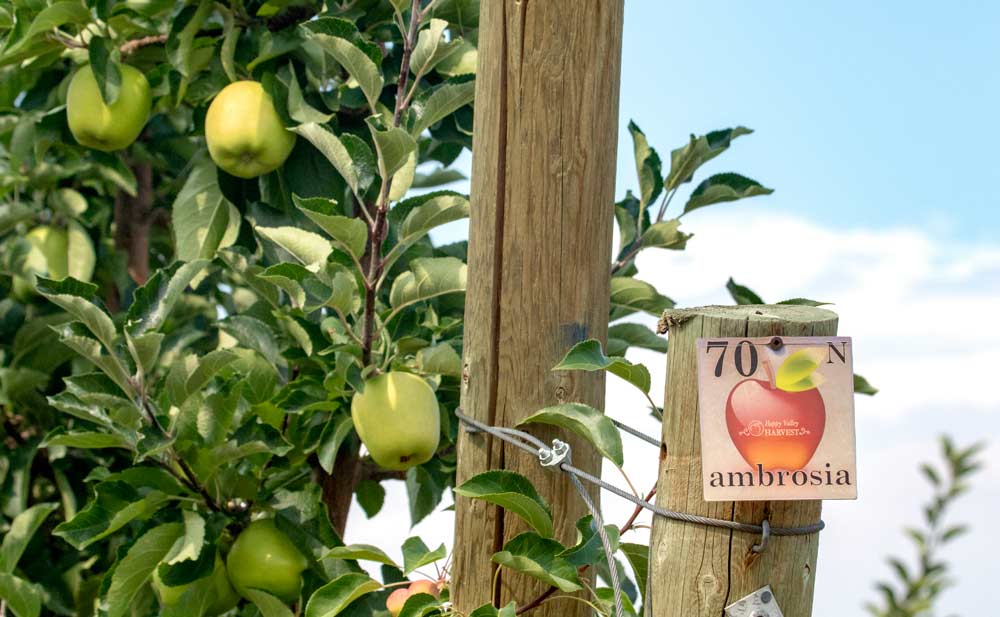
High-density Ambrosia apples at Happy Valley Harvest orchard in Summerland, also part of the summer tour. (TJ Mullinax/Good Fruit Grower)
Ambrosia opens up
Ambrosia has been Canada’s ace in the hole for 20 years.
Developed as a chance seedling by a British Columbia family, the variety was public in Canada but managed everywhere else. Since 2005, McDougall & Sons of Wenatchee, Washington, had the only U.S. license.
Last year, the 20-year patent expired and nurseries began propagating for open planting by 2019, opening it up to growers in the United States, as well as Canada. It’s still protected in other regions of the world.
This time, growers aren’t waiting for another chance seedling. They hope the answer lies somewhere among the 30,000 unique apple varieties in various stages of development at Agrifood Canada’s Summerland Research and Development Centre.
Besides the vast rows at the research station, varieties are tested at 22 on-farm sites scattered throughout Canada, as well as various international testing sites in the U.S., South America and Europe.
“We’re looking for that next best thing for Canada,” said Nick Ibuki, business development manager for Summerland Varieties Corp., a private company that works with the center to commercialize new cultivars.
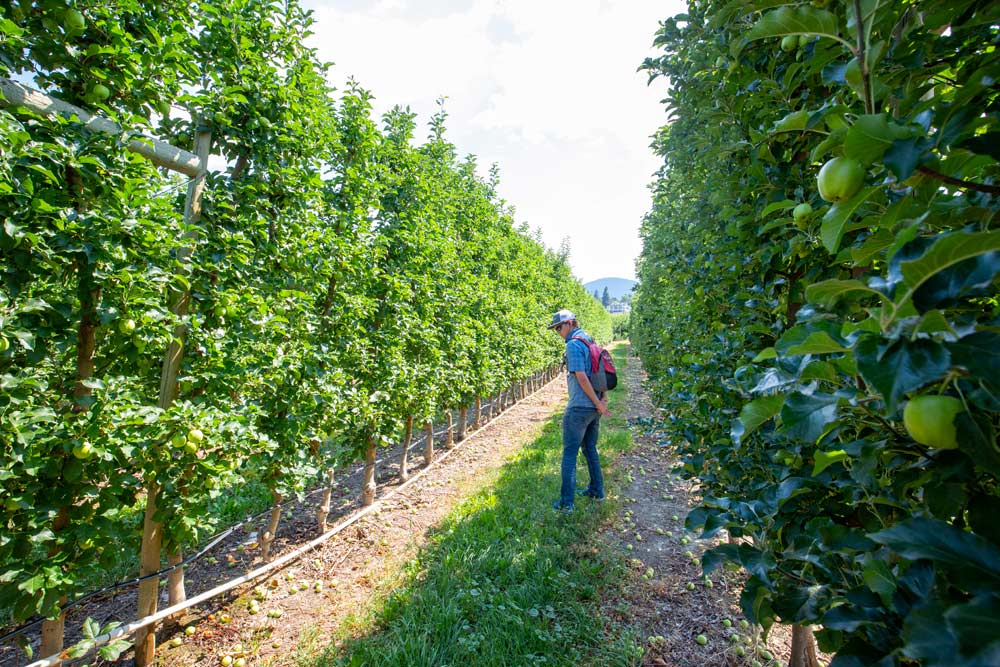
Aaron Waybright, a grower from Gettysburg, Pennsylvania, checks out planar rows of Smoothee Golden Delicious apples in a Happy Valley Harvest orchard in Summerland. (TJ Mullinax/Good Fruit Grower)
The search is on
So is Hank Markgraf, field services supervisor for BC Tree Fruits, a grower-owned cooperative in Kelowna.
The company tasked Markgraf, known for his industry connections with groups such as IFTA, with searching the world for new varieties that would work in British Columbia. He’s still looking.
“Is it Jazz? Probably not. Is it Envy? I don’t know,” Markgraf said.
The cooperative represents about 75 percent of the apple growers in British Columbia.
Some club varieties are willing to deal with smaller acreages and don’t require large outlays of cash to buy in, he said.
For example, BC Tree Fruits is talking to the Midwest Apple Improvement Association, owner of the rights to the EverCrisp apple. Markgraf also has been eyeing breeding programs in New Zealand, Europe and other places in Canada.
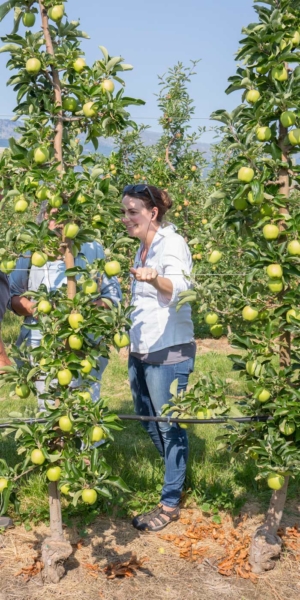
Nursery owner Jen Baugher of Aspers, Pennsylvania, and other tourgoers check out the pruning cuts on some of the first Ambrosia plantings in British Columbia at Dorenberg Orchards. (TJ Mullinax/Good Fruit Grower)
The first hurdle is determining whether the fruit will grow in the arid British Columbia climate. Then, they have to get past Canada’s strict plant virus protection laws.
And no one is giving up on Summerland, he said. The research station has churned out great tasting apples in the past decade or so — Salish, Nicola and Aurora Golden Gala — but they either bruised easily on commercial packing lines, didn’t store well or for some other reason languished as a niche variety.
So, the search continues. Markgraf’s goal is to keep contact with as many industry leaders as possible, so they think of him — and therefore British Columbia — when they want to launch a new trial.
“It’s about relations and relationships,” he said.
Van Roechoudt, a BC Tree Fruits grower, feels a sense of urgency.
Dorenberg Orchards has always been known for new varieties and techniques.
Her grandfather, Louis from Belgium, was one of the first in British Columbia to plant at high densities on dwarfing rootstock and developed a trellis mentioned in local horticultural textbooks.
Her father, Marc, a geological engineer, used his drafting background to perfect the trellis design and was usually one of the first to test and adopt new varieties.
In the 1990s, the orchard was an early adopter of Ambrosia, fetching $1,000 per bin in one of the early years.
So, the company has been consolidating and moving away from the McIntosh and Jonagold varieties.
Today, they grow 45 acres of apples — 20 Ambrosia, 20 Gala and 5 Sunrise, a niche variety they field pack and sell direct through BC Tree Fruit’s fresh market.
Now is the time for something new, she said.
“Honestly, it’s already five to 10 years too late because we need the production now. So yeah, it leaves a big question mark.” •
—by Ross Courtney






Leave A Comment